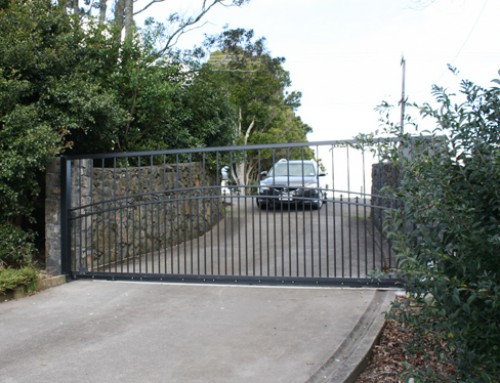Short answer to the titular question: Yes.
The longer, more accurate answer: Yes, but there are some limitations.
Sorry we couldn’t keep it simple, but you’ll If you already have a single swing gate or a double swing gate, there are a few things you’ll want to think through. The first is to take a good hard look (or a cursory look, if you prefer) at the type and strength of the post(s) that flank each side of your gate. If the posts are wood, they will need to be replaced before you can have your gate automated. If there are no visible posts and the gates are hung off of masonry columns, we’ve now got a more complicated issue since automation with the existing columns may not be possible. Here’s more on that: With existing manual swing gates, it is very common that the hinges that attach from the posts to the gate will need to be replaced–usually this is a fairly straight-forward process. You didn’t think we’d stop our list of limitations after only a few paragraphs did you? We’ve got a few more paragraphs to go. Those that follow are on the limitations that stem from the type of gate you currently have installed and how that affects your ability to automate your gate. As lovely as they are, most wood frame gates cannot be properly automated. But, like almost everything else we’ve so far discussed, there are a few exceptions here as well. Heavy-duty, thick hardwood gates count among these exceptions. Your typical flexible, thin wood gate is not a candidate for automation. If you really love your existing wood gate, one option is to have an automated gate contractor build a steel frame and mount your existing wood gate to that frame. This can help you maintain that rustic or natural look that you enjoy, yet give you a gate this is strong enough to withstand the rigors of being opened and closed by a gate opener. If a chain link gate is what you’ve got, well you’re in luck–many chain link gates can be automated without needing many improvements. Oh but here we go with the exceptions again: Some exceptions to the above are gates that are built with thin material, and exhibit excessive sagging and flexing. Chain link is not very expensive to replace and, in if you’re dealing with a sagging or thin gate, replacement is the best option. Also, oftentimes, additional steel will need to be welded to the gate to provide an attachment point for the gate operator. Most, if not all, steel frame gates can be automated, and typically with little alterations necessary. Manual slide gates are a different matter entirely. Most existing manual slide gates require extensive improvements in order to be automated. Typically, your gate needs to be 3’ longer than the opening that it slides across in order to accommodate the installation of a slide gate operator. This means that, often, a 2 foot to 3 foot extension needs to be added to the trailing edge of the gate in order to provide a place for the gate operator chain brackets to attach to. Another area that usually requires a check-up is the rolling hardware. If your gate has rubber wheels and rolls across the driveway, a ground “V”-track will need to be installed, and a “V”-track wheel will be installed to replace one of the rubber wheels. In fact, the entire wheel carriage may need to be replaced depending on the structure of the wheel carriage. And beyond that, the rear guide wheels may need to be altered. To take it one step further, depending on how the gate is built, ground track may need to be installed, or new pipe track may need to be installed. Phew. That was a lot to digest. Our point with the encyclopedic wheel info isn’t to send your head spinning with information overload. Truth is, it doesn’t matter too much if you remember exactly under what conditions you might need a “V”-track wheel or altered guide wheels. What’s most important is that you feel informed and not taken aback should your gate installer suggests a number of modifications to your existing slide gate before it can be automated. Now with all the exceptions and limitations you’ve just read above, the good news is that, most of the time, your existing gate can be re-used with just a few tweaks to make it automation-ready. Of course a professional gate installer can walk you through exactly how to get your gate ready for the transformation.Manual Swing Gates
Swing Gate Posts
The Hinges That Hold Things Together
The Gate Part of the Swing Gate
Wood Swing Gates
Chain Link Swing Gates
Steel Frame Swing Gates
Manual Slide Gates
The Length of Your Slide Gate
Rolling Along — Slide Gate Wheels
Summing it Up






